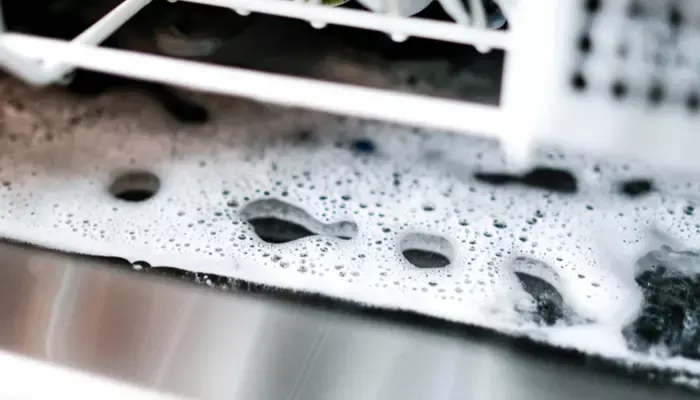Are you searching for a quick fix to “standing water in dishwasher?”
If so, you’re in the right place. Read on to learn about causes dishwasher drain issues, easy fixes, and when to call a pro.
We partnered with Networx to help you find local appliance repair techs. Click to below to get a FREE quote.
Standing Water in Dishwasher: Common Causes
A functioning dishwasher should fully drain after each cycle.
If you notice standing water in a dishwasher, there’s a problem with one of the parts causing it not to drain properly.
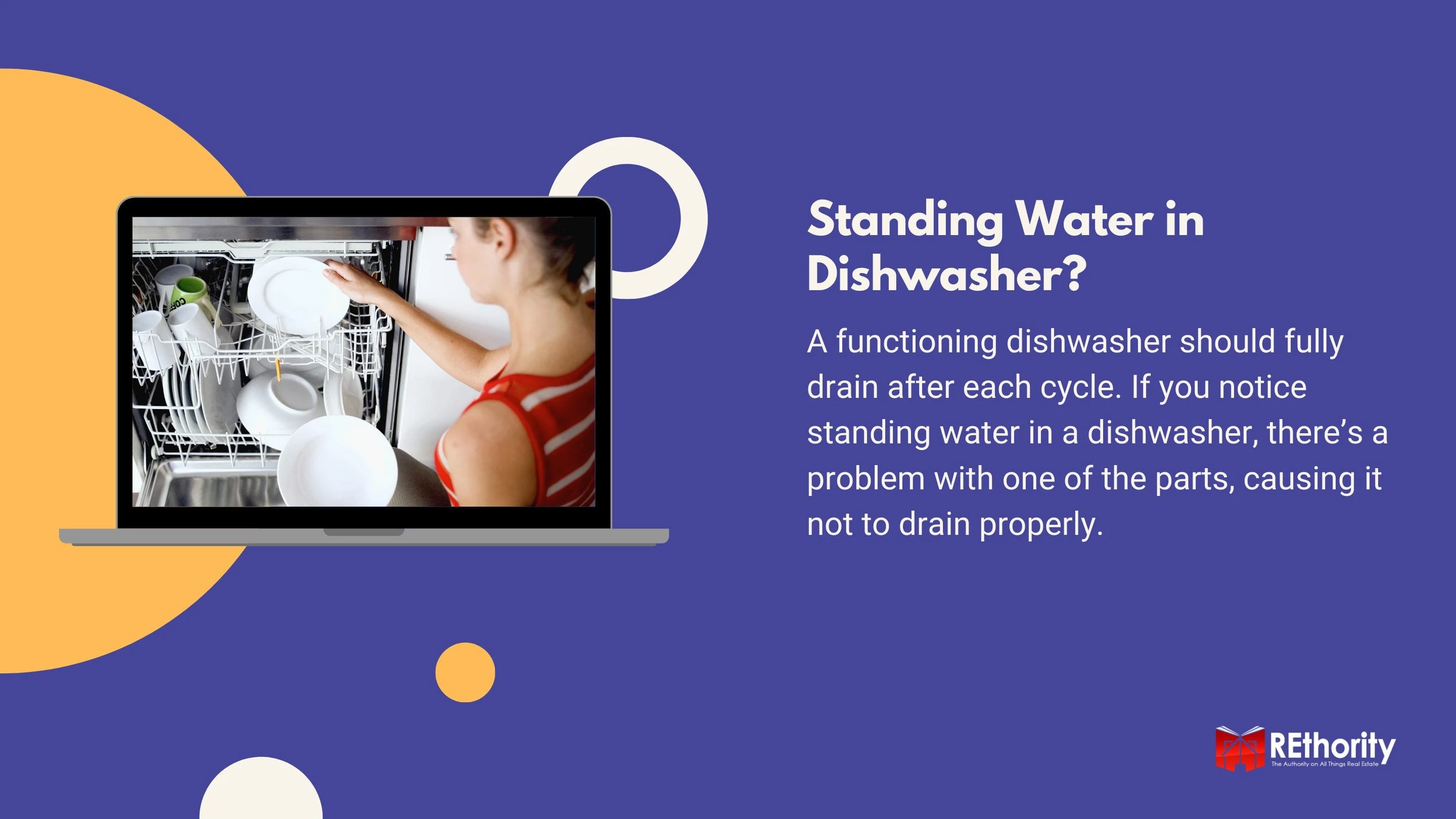
It could be an issue with any part of the drainage system: The drain pump, drain hose, filter, drainage pipe, drain valve, air gaps in hoses, or clogs in the drain line.
Some problems that cause standing water in a dishwasher are easily fixed with limited tools and plumbing experience. Some require an appliance repairman’s expertise.
We’ll walk you through the different possible causes of standing water in your dishwasher, when you can fix it yourself, and when to call a pro.
Common Causes for Standing Water in Dishwasher
Warning: Before you do anything, unplug your dishwasher and make sure it is not connected to power.
Electricity and standing water aren’t a good combination.
Bale out as much standing water as you can with ladles, bowls, or cups. Try to soak up as much of the water as you can with towels.
When you notice standing water in your dishwasher, it’s likely caused by one of the following issues.
Clogged Drain or Drain Filter
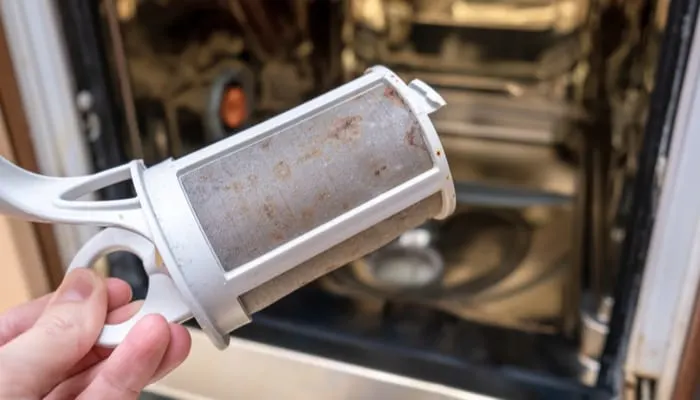
Nadezhda Mikhalitskaia/Shutterstock
Your dishwasher uses clean water to spray and clean your dishes during a wash cycle. When the dishes are clean, the dirty water drains out of the dishwasher.
Where the water drains from your dishwasher, there is a small filter that helps capture any large food particles or debris.
The filter’s job is to keep these particles from interfering with the pump or recirculating and sticking to your dishes during a wash cycle.
When the drain is clogged, the dirty water has nowhere to travel. It sits in the bottom of your dishwasher and results in the standing water you’re seeing.
If the drain filter is clogged, it prevents the dirty water from draining out fully (or at all).
Fixing a Clogged Drain or Drain Filter
A clogged drain filter is often the culprit for standing water in a dishwasher. To fix it, you just need to take it out and give it a deep cleaning.
- Remove all dishes and the sliding dish racks from your dishwasher for easy access.
- Under the spray arm at the bottom, look for a small filter shaped like a cylinder. You will need to turn it clockwise or counterclockwise, depending on your dishwasher make and model. Lift it straight up.
- Check for a coarse filter. The cylindrical filter would have been holding it in place, so with it removed, the coarse filter will slide right out.
- With the drain opening, called the sump, fully visible and accessible now, shine a flashlight in to see if you can detect any blockages. If you can reach in to feel for blockages, wear gloves – whatever is blocking the drain is sure to be slimy, grimy, and smelly. There could be food debris, bones, or even broken pieces from dishes.
- Sprinkle about 1/2 cup baking soda into the drain opening and let it sit for a few minutes.
- Pour 1 cup of vinegar + 1 cup of hot water directly onto the baking soda. It will bubble and fizz. Cover with a washcloth to keep the mixture in the drain and let it sit for 10 minutes.
- Pour 1 cup of hot water to flush the baking soda/vinegar mixture down the drain.
- With the filters out of the dishwasher, use hot, soapy water to clean them thoroughly. First, it’s helpful to let them soak in hot, soapy water to soften or loosen any food particles. Use a scrubbing brush to clean it off inside and out after soaking.
- Reinstall the filters. The coarse filter goes in first. Then, the cylinder filter fits in on top. Twist it into place to make sure it’s secure. Give the spray arms a spin to make sure you’ve properly reinstalled the filters.
- Run a short dishwasher cycle to test if the drain and filter cleaning solved your problem.
Call a Pro If…
If you detected a major blockage in the dishwasher drain that you couldn’t remove, you should call a dishwasher repair expert.
You could potentially damage the drain pipe by removing it on your own or push it further into the pipe.
Clogged Air Gap
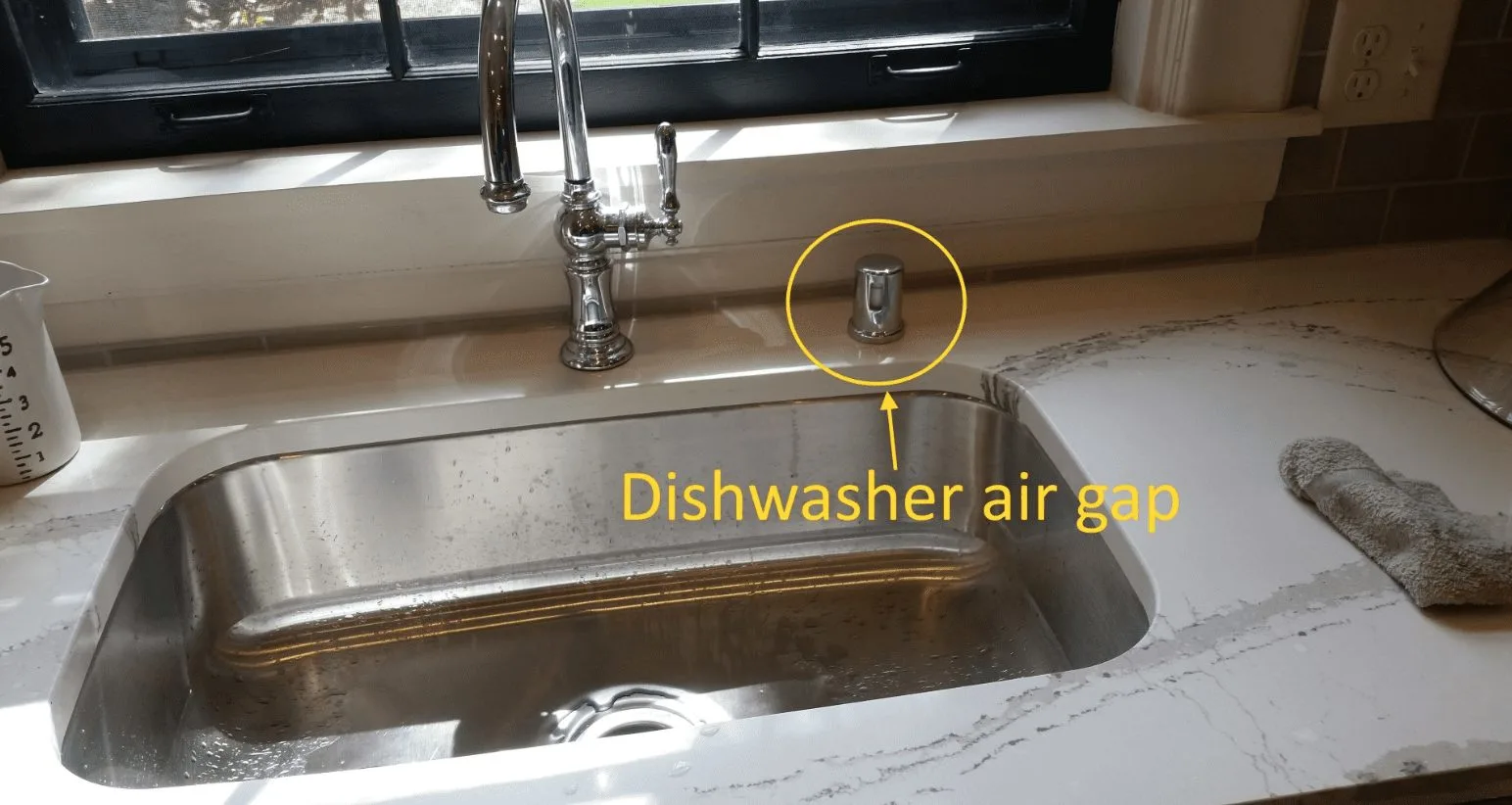
Image Source: Homesmsp.com
Your dishwasher may have an air gap that stops dirty water from coming back into the dishwasher and contacting your clean dishes.
If the air gap becomes clogged, it doesn’t work to stop the backflow of water and can prevent your dishwasher from draining.
You can check to see if a clogged air gap is the reason for standing water in your dishwasher by following these steps.
- Look for a silver cylinder-shaped part near your kitchen sink faucet. You may or may not have one. This will be the air gap.
- If you do, remove the top covering by pulling straight up on it. There will be either tabs you can press to release or screws holding it in place. Use a screwdriver or press the tabs to release it.
- Look to see if food particles, debris, or mineral buildup.
- Replace the pieces in the correct order to reassemble the air gap.
- Run a short dishwasher cycle to see if the clogged air gap was the problem.
Call a Pro If…
If you’re not able to locate the air gap or are concerned you won’t be able to reassemble it properly and securely, call a pro to do this.
They’ll not only locate, disassemble, and clean the air gap, but can also identify the problem if it is not with the air gap.
Kink or Clog in Drain Hose
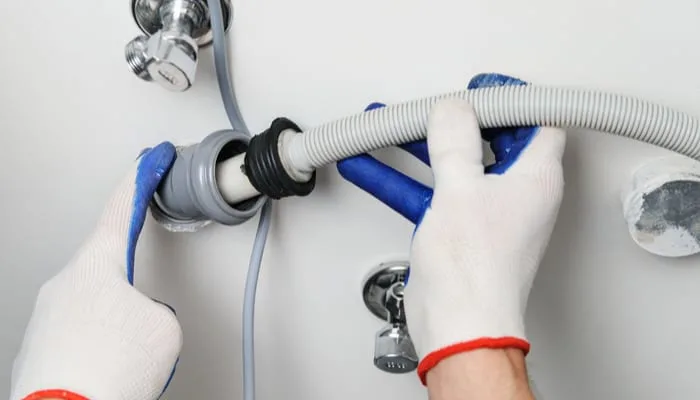
Duo Studio/Shutterstock
Your dishwasher drain hose could have a kink in it, preventing water from fully draining out of the machine after a wash cycle.
Just like a kink in a garden hose prevents the water from spraying or reduces the pressure, a kink in your drain hose prevents water from moving away from the dishwasher.
A kinked drain hose is easy to fix if it’s not damaged from the kink.
- Check under the sink where the dishwasher drain hose connects to the drain (or garbage disposal leaks).
- Look for a kink or bend in the drain hose. If you see one, carefully turn or bend the hose out of the kinked shape.
- Ensure cleaning products and other items under your sink aren’t interfering with the drain hose or causing it to kink.
- If you didn’t see a kink under the sink, remove the kick plate on the front of your dishwasher (if you turned the power to your dishwasher off earlier, this should still be removed).
- Find the opposite end of the drain hose you just checked, which will be connected to the drain pump at the bottom of the dishwasher.
- Shine a flashlight on the drain hose to look for any kinks or bends in the hose that could prevent it from functioning properly.
While you’re checking for kinks, you may as well go ahead and troubleshoot to see if the problem could be due to a clogged drain hose.
- Remove the drain hose from the dishwasher by loosening the hose clamp.
- Look inside the hose. Shine the flashlight down into it. If you have a long, flexible brush, use it to clear any blockage.
- If you don’t have a long, flexible brush, try spraying water down the drain line to clear away any blockage or clog.
- Reconnect the hose and hose clamp, then run a short cycle to see if the kinked or clogged hose was the problem.
Call a Plumber If…
If you see that your drain hose was kinked badly, you may want to call a plumber to have them replace the hose.
Long-term kinks can weaken the integrity of the hose and result in major leaks that cause water damage.
If you’re unable to clear a clog in your drain hose manually, a plumber can use specialized tools to clear it without damaging it.
Drain Valve
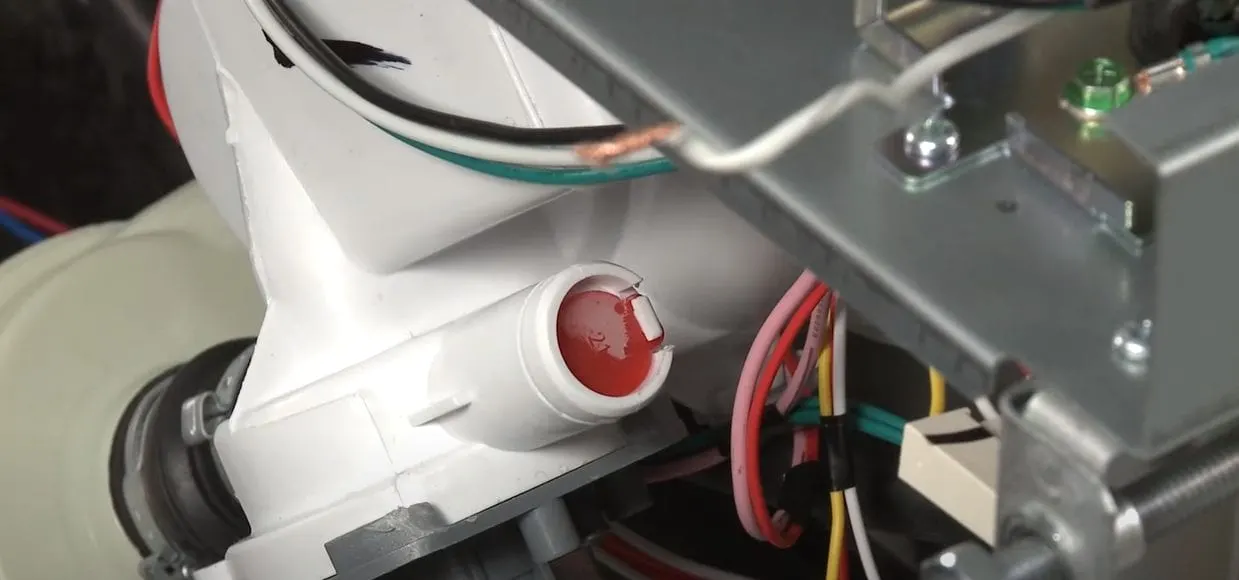
Image Source: Repairclinic.com Youtube Channel
Your dishwasher’s drain valve, like an air gap, works to keep dirty water from moving back into your dishwasher after it’s been drained.
If the drain valve is stuck in one position, it may prevent water from draining, or may only allow small amounts of water to drain.
This would result in the standing water in the dishwasher. Checking your drain valve is a little more complex than the other troubleshooting tips so far.
There are lots of parts around it. If you want to check it anyway, follow these steps.
- Allow the dishwasher to cool down completely if you’ve recently run a cycle and make sure you have the power to the dishwasher disconnected.
- Remove the kick panel (if you haven’t already) on the front of the dishwasher.
- Find the drain valve near the motor. The drain valve has a gate arm with two springs attached and a solenoid or coil. The gate arm should move freely when you manipulate it.
- If either of the springs is missing or damaged, they will have to be replaced for the drain valve to be functional.
- The solenoid is connected to 2 wires, which you will need to disconnect carefully.
- Use a multimeter to test the solenoid’s resistance. It should read 40 ohms. If you get a different reading, the solenoid needs to be replaced. If it reads correctly, reconnect the two wires exactly as you found them.
- While you’re near the motor, try spinning it. If it feels stuck but begins to spin, it may be locked up due to inactivity. Turning it allows the water to drain.
- Once you’re certain everything is back in its place, try running a short cycle to see if turning the motor fixed it.
Call a Pro If…
If you see missing or damaged springs attached to the drain valve’s gate arm, you need to call a pro to replace and install them.
If you don’t have a multimeter to test the solenoid, or if your multimeter reading showed something very different from 40 ohms when you tested it, call an appliance repair pro.
They will need to replace the solenoid. They’ll have the parts, knowledge, and experience to correctly and efficiently diagnose the problem.
Broken Drain Pump
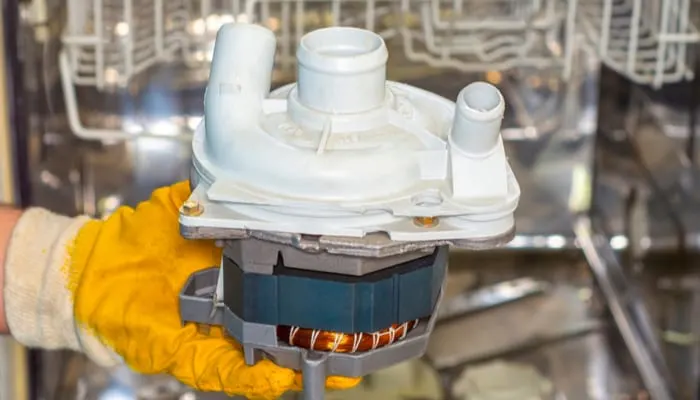
Darkdiamond67/Shutterstock
A broken or malfunctioning drain pump can cause water to stay in the dishwasher without draining. The pump’s job is to pull water from the dishwasher and carry it into the drain line.
The drain pump assembly is composed of a few parts, and if any are broken or not working properly, the water won’t drain.
You might hear a humming or buzzing sound from your dishwasher when it runs if there is a problem with the pump. There are two impellers in your dishwasher.
One, the wash impeller, pumps water into the machine. The other, the drain impeller, pumps dirty water out.
If something is stuck inside the lower impeller that pumps water out, it could prevent your dishwasher from draining.
If you see any food or debris clogging or blocking the drain impeller, remove it. Otherwise, dishwasher pump repairs should be left to a professional.
Call a Pro If…
If you hear the telltale buzzing, clicking, or humming sounds from your dishwasher, it’s an indicator of the problem with the pump assembly or the motor.
Either of these problems requires the expertise of a professional. Your pump may or may not need to be removed and completely replaced.
Troubleshooting Standing Water in Dishwasher
Any of the common causes above can result in standing water that won’t drain out of your dishwasher.
As a homeowner, it’s great to be able to do a simple repair.
It’s also easy to dislodge a clog that prevents your dishwasher from working as it should. However, dishwashers are somewhat complicated kitchen appliances that have hundreds of parts.
We partnered with Networx to help you find local appliance repair techs. Click to below to get a FREE quote.
When to Call a Pro
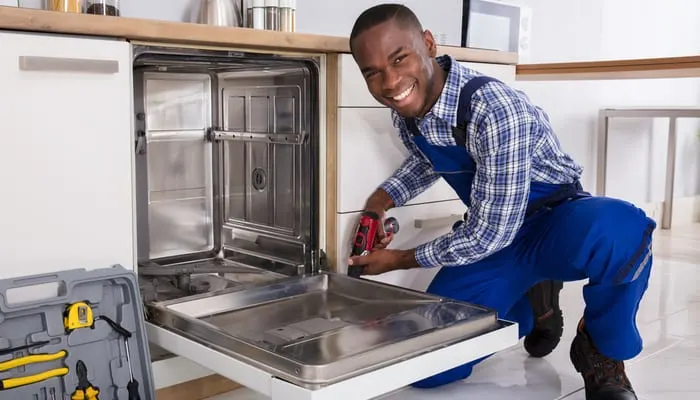
Andrey_Popov/Shutterstock
If you’re not sure what you’re doing, it’s easy to make a mistake, connect the wrong parts together, damage a part, or expose yourself to the risk of electrical shock.
If the problem is as simple as a clogged filter or air gap, you’ll probably feel confident to handle the solution yourself.
For problems with damaged drain hoses, drain valves (including gate arms, springs, and solenoids), the drain pump, or motor, you need to call a professional.
If you can’t determine the problem, a professional will quickly identify the culprit. An appliance repair pro will recognize any worn or defective parts that are causing the dishwasher not to drain.
By calling a professional, you can ensure you don’t waste time and money replacing parts that may be able to be fixed.
Resources:

